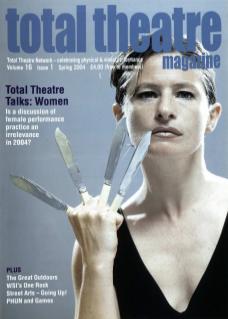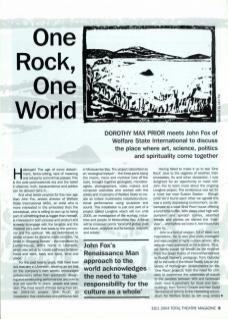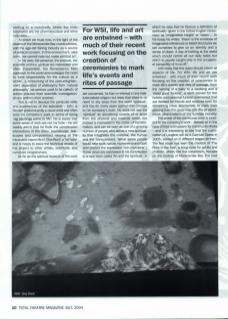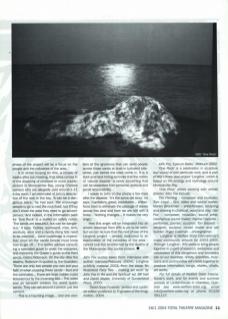Hallelujah! The age of ironic detachment, fence-sitting, lack of meaning and refusal to commit has passed. This is the post-postmodemist era and the belief in essence, truth, transcendence and politics can be allowed back in...
And what better prophet for this new age than John Fox, artistic director of Welfare State International (WSI), an artist who is more interested in the embodied than the conceptual, who is willing to own up to being part of something that is bigger than himself, is interested in both process and product, and is ready to engage with the tangible and the material on a path that leads to the communal and the spiritual. 'We are determined to devise a haven for dreams made concrete,’ he wrote in Stepping Stones – the manifesto for Lanternhouse, WSI's home in Ulverston, which was set up to 'create pathways between hand and work, body and spirit, time and place’.
For the past twenty years, WSI have lived out that aim in Ulverston, creating an art that (in the company's own words) encourages collaborators rather than spectators, designing and constructing performances and events that are specific to place, people and occasion. The most recent of these being their winter 2003-04 project One Rock, an installation that celebrates one particular rock in Morecambe Bay. The project (described as an 'ecological triptych' – the three parts being the macro, micro and mythical lives of the rock), brought together geologists, microbiologists, photographers, video makers and computer scientists who worked with the artists and musicians of Welfare State to create an indoor multimedia installation / durational performance using sculpture and sound. This installation is just one part of a project called Longline which will run until 2005, an investigation of the ecology, industries and people of Morecambe Bay. A focus will be crossover points 'local and global, past and future, analytical and fantastical, scientific and artistic’.
Having failed to make it up to see One Rock (due to the vagaries of weather, train timetables, flu and other obstacles), I was delighted for an opportunity to meet with John Fox to learn more about the ongoing Longline project. The rendezvous was set for a hotel bar near Euston Station – though once we'd found each other we agreed this was a pretty depressing environment, so decamped to a local Bhel Poori house offering a lunchtime buffet. With plates piled high with pumpkin and spinach curries, assorted breads and pickles we started the interview... and before we knew it, two hours had gone by...
John is a font of wisdom, full of ideas and inspirations. He is also (like most intelligent and wise people) a highly curious person, who asks as many questions as he answers. Thus, we hardly pause for breath as we ricochet from the Gaian theory of interconnectedness to Rudolf Steiner's pedagogy, from Outsider Art to the work of the Mixed Reality Lab at University of Nottingham (collaborators on the One Rock project); from the need for children to experience the wilderness of nature to the parallels between WSI and Grotowski (both have a penchant for ritual and barn-building); from Tommy Cooper and Ken Dodd (favourites of John's) to the interesting conundrum for Welfare State as left-wing artists working in a community where the main employers are the pharmaceutical and arms industries...
To which we must now, in the light of the deaths of the Morecambe Bay cockle-pickers, add the age-old fishing industry as a source of political concern. In this environment, says John, ‘we cannot help but make political art'.
In his view, the personal, the political, the scientific and the spiritual are interrelated and often inseparable. His Renaissance Man approach to the world acknowledges the need to ‘take responsibility for the culture as a whole', a renouncing of the post-enlightenment separation of philosophy from 'natural philosophy' (as science used to be called); of artistic practice from scientific investigation; of one artform from another.
This is not to devalue the particular skills and experiences of the specialist – John is himself predominantly a visual artist and often sees his company's work in terms of being 'big paintings come to life’. He is aware that some areas of work are not his forte – he will readily admit that he finds the complicated interactions of the video, soundscape, telescopes and computerised relaying of the micro and macro life in One Rock a 'bit hairy’ and is happy to leave the technical details of the project to other artists, scientists, and computer programmers.
As far as the spiritual aspects of the work are concerned, he has no interest in any institutionalised religion but feels that there is no need to shy away from the word 'spiritual', and has for many years applied this concept to his company's work. He does not see the 'spiritual’ as something outside of or apart from the physical and material world, but instead is interested in the notion of transformation, and can be seen as one of a growing number of people who define a new spirituality that integrates the material, the human and the transcendent. (What some people would refer to as nature, humankind and God! John prefers the expression 'non-mundane'.) These views are expressed in his contribution to a new book called Art and the Spiritual, in which he says that he favours a definition of spirituality (given in the Oxford English Dictionary) as 'imaginative insight' or 'vision'... In his essay he writes: ‘Vision is the envelope of imaginative references or belief structures we set ourselves to give us an identity and a sense of place. A way of looking at the world which should centre all our daily tasks but which is usually caught only in the occasional tranquillity of time off.'
John feels that this vision should inform all aspects of life. For WSI, life and art are entwined – with much of their recent work focusing on the creation of ceremonies to mark life's events and rites of passage, from the naming of a baby to a wedding and a ‘dead good funeral', a term coined for the holistic and personal funeral ceremonies that are devised for friends and relatives keen for something more appropriate to mark their grieving than the usual one-size-fits-all piped music abominations of the funerals industry.
The power of the communal voice is inherent to the company's work – literally so in the case of their enthusiasm for community choirs – and it is interesting to see that the culmination of Longline will be a Carnival Opera in 2005, worked on in different stages till then. The first stage has seen the creation of The Rock in the Sea, a song-cycle for adults and children, which, like the installation, focuses on the ecology of Morecambe Bay. The next phase of the project will be a focus on the people and the industries of the area.
It is whilst musing on this, a couple of weeks after our meeting, that news comes in of the drowning of nineteen or more cockle-pickers in Morecambe Bay, young Chinese workers who are allegedly paid around a £1 a day each. I am reminded of John's description of the rock in the bay. ‘It can be a dangerous place,' he had said. ‘We encourage people to go to visit the rock itself, but if they don't know the area they need to go accompanied.' And indeed, in the information pack for One Rock is a leaflet on safety notes. 'The sands are beautiful, but can be dangerous,' it says. ‘Gullies, quicksand, mist, temperature, wind and a rapidly rising tide need to be watched... Local knowledge is imperative; once on the sands people must know how to get off...’ The leaflet advises consulting a specialist guide to cross the estuaries, and mentions the Queen's guide to the Kent sands, Cedric Robinson. On the day after the deaths, Robinson is quoted by the Guardian: ‘There are only two people you can put your faith in when crossing these sands – God and the sand pilot... There are large hidden holes scoured out by the incoming tide... The water and air beneath creates the worst quicksands. They can set around a person just like cement.'
This is a haunting image... and one wonders at the ignorance that can send people across those sands at dusk in turbulent late-winter, just before the tides come in. It is a stark and hard-hitting reminder that the notion of 'natural’ disaster is rarely something that can be separated from personal, political and social responsibility.
I speak to John on the phone a few days after the disaster. 'It's the same old story,’ he says. ‘Capitalism, greed, exploitation... Wilberforce tried to eliminate the passage of slaves across this land and here we are still with it today... Nothing changes... It makes me very angry.’
How this anger will be integrated into an artistic response from WSI is yet to be seen, but we can be sure that the next phase of the Longline project – already dedicated to an examination of the industries of the area – cannot help but be informed by the deaths of the Morecambe Bay cockle-pickers.
John Fox quotes taken from: interviews with author (January/February 2004); Longline publicity material 2003; from the essay ‘An Illustrated Fairy Tale - making art work’ by John Fox in Art and the Spiritual ed. Bill Hall and David Jasper, University of Sunderland Press, 2003.
Dead Good Funerals revised and updated edition published by Engineers of the Imagination, 2004.
John Fox, Eyes on Stalks, Methuen 2002.
One Rock is a celebration in sculpture and sound of one particular rock, and is part of WSI's three-year project Longline, which is based on the ecology and mythology around Morecambe Bay.
One Rock artists working with artistic director John Fox include:
Tim Fleming - composer and musician; Tom Lloyd - film, video and sound maker, Martin Brockman - artist/forester, sculpting and drawing in charcoal, wood and clay, Dan Fox - composer, musician, sound artist, mechanical sound maker, Rachel Capovila - performer, painter, sculptor, Tori Bassett - designer, sculptor, model maker and set builder, Roger Coleman - photographer.
Longline is Welfare State International's major community artwork for 2003-2005. Through Longline, WSI seeks to bring people together in a spirit of research, awareness and celebration of this dangerous and wondrous site on our doorstep. Artists, scientists, musicians and communities will create together to produce information, songs, stories, choirs, art works.
For full details of Welfare State International's work, and for events and summer schools at Lanternhouse in Ulverston, Cumbria see www.welfare state.org, email info@welfare state.org or phone 01229 581127.



